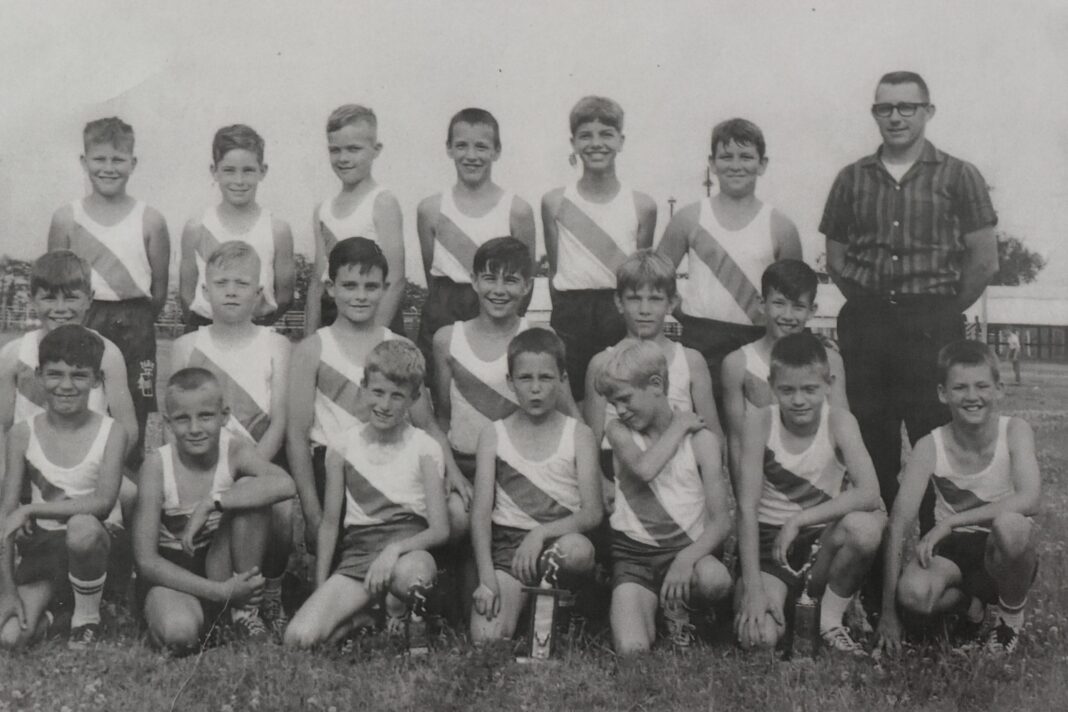It was a beautiful fall day in Paris. It was cool and sunny, and everywhere you looked, the squirrels were busy going about their work of storing food for the upcoming winter. And on this day, I had the privilege to sit down with Paris’s legendary Boys Club founder, long-time director, and mentor to hundreds of young boys, Mr. Bentley Allen. Mr. Allen and I met at The Grapevine restaurant in Paris and I recorded his interview for this story. Later that day, he took me to the Paris Boys Club and shared with me what was one of the biggest passions of his life; that of bringing the Boys Club to Paris, and his work with so many young boys who have grown up to revere this special man.

Being fairly new to the Paris community, I had heard of Mr. Allen and that he had brought the Boys Club to Paris, and, of course, every time I heard someone mention his name, I could hear the love and affection for this man. So, I had to interview him. I wanted to hear his story, and I wanted to tell his story to anyone out there who didn’t know just how special Mr. Allen is. So, when I first contacted him, he was very modest and almost reluctant to do the story. But he was very gracious and consented to the interview, and I am so glad that he did.
As Mr. Allen told his story, I quickly realized that I was in the presence of a truly special human being. Mr. Allen is a compassionate man who loves children and went on to be a huge influence to so many. And one of the most extraordinary facts about Mr. Allen’s story was how soon in his life he made a difference in the Paris community. By the time Mr Allen was in his mid to late twenties, he had already accomplished great things that were making a difference for not only the children of Paris, but many of the communities surrounding Paris as well. But perhaps most heart warming of all, Mr. Allen included all children, regardless of race. And for him, it was no big deal. He loves all children, and today, many of those children have thanked him for his work, influence in their lives, and for being a major factor in the successes they have enjoyed in their adult lives. Mr. Allen’s story is very special, and I hope you enjoy reading it as much as I have enjoyed sharing it with our readers.
Mr. Bentley Allen came to Paris from the community of Guy in north central Arkansas. As a college student at the University of Central Arkansas (known at that time as Arkansas State Teachers College) , he was assigned by his college to perform his student teaching (known as practice teaching then) to the Paris School District. Once he arrived in Paris, he fell in love with the community, and he never left it. Thus began a love affair between a man and his community. It was also where he met and married the true love of his life, his wife Carolyn.
Mr. Allen was assigned to the Paris School District as a practice teacher in 1958. Until that time, Mr. Allen had not heard of the town of Paris. Mr Allen began by saying, “I was a student, it was Arkansas State Teachers College back then, and they send their students out to do their student teaching. He asked me where I would like to go, and I didn’t have any idea where I wanted to go. He then said, how about Paris, Arkansas? I said, well, where is it? At that time, I had no idea what the good Lord had in mind for me. And I certainly have not regretted any day that I got to live in the community and know the people. It struck me that the community was so supportive of me when I got here, and the school, and I just fell in love with the community. So, as history will show, I spent forty years up there teaching and 25 of those in coaching. Then I had the privilege of helping organize and run the Boys Club here in Paris that has been my passion ever since I took over a summer program that the city had at the time. We took on the dream of maybe having a Boys Club, and that’s what it was at that time. It has since developed into a Boys and Girls Club, thank goodness. That was one of the highlights that I will always remember as something I had a privilege of being a part of.”

Mr. Allen moved to Paris in the spring of 1957. “My first teaching was in 1958 when they (Paris School District) hired me on. I taught seventh grade math and science for three or four years. Then I moved into the junior high and high schools math and that’s where I remained. When I retired, I was teaching some of the higher level math; Algebra 2, Trigonometry, and Algebra 3. I had some wonderful students. After that, I think about seven years went by, I was hired to teach part time at Subiaco Academy. I did that for three years. That was a good experience for me.”
Mr. Allen was single when he started his career with Paris. He went on to say, “I was single at the time and lived in a rooming house down the street here, and my wife was going to Arkansas Tech, and we got introduced. It was 65 years ago last August.” Mr. Allen recollected that he then retired from the Paris school district in 1995.
The story of how Mr. Allen brought the Boys Club to Paris is truly remarkable. What makes it most remarkable was the young age that Mr. Allen was at the time to follow his dream and turn it into a reality. In his mid to late twenties, Mr. Allen explored the possibility of bringing a Boys Club chapter to Paris. He did all of the leg work; he worked with politicians, city government, the United States Army and the National Guard, and then Arkansas governor Orval Faubus.
But before I continue Mr. Allen’s story, you have to remember the historical context of the day and time he organized the Boys Club. Mr. Allen had just moved to Paris as a young man who had just graduated from college. Just three years earlier, the United States Supreme Court had ruled in the landmark case of Brown v the Topeka Board of Education that the concept of “separate but equal” were in fact, not equal at all. The Brown case became the landmark court case that began desegregation of public schools in the United States.
Now, move forward a little bit to 1955 and the election of Orval Faubus as governor of Arkansas. Faubus held office as Arkansas’ governor from 1955 to 1967. In 1957, the same year that Mr. Allen moved to Paris, Governor Faubus resisted the Supreme Court’s Brown decision and the integration of Little Rock Central High School. Eventually, “The Little Rock Nine”, nine African-American students, were integrated into Little Rock Central by order of the United States Department of Justice and under the protection of the United States Army’s First Airborne Division.

Now, within this historical context, I will resume Mr. Allen’s story. “Paris had a summer program, and we had some little ball teams of different age groups that we played against all of the surrounding areas. We participated in the Fort Smith tournament. There was a man by the name of Iris Lawless who was originally from Paris, and he was the Boys Club director at Hot Springs. He invited our baseball team down there and they (the Hot Springs Boys Club) took them out to the lake, let them spend the night, visit the Boys Club there, and our kids just had a great time. So, we came back to town, and Mr Spec Breed, said, “Why can’t we have that (a Boys Club)?”
So began the dream, and the two men sat out to make the dream a reality for the children of Paris and the surrounding communities. “We approached the City Council and the Chamber of Commerce about it. They weren’t enthusiastic about it at all because of our size of community. They didn’t think we would be able to do anything like that. But we convinced them to at least listen to Boys Club of America. They sent a representative to Paris and talked to a group of men and they said we don’t know how can do it, either. Because Boys Club had regulations of town size, population, and other things, so someone came up with the idea that we might become a branch of either the Fort Smith or the Hot Springs Boys Clubs. We might be able to go in that direction. And so after much discussion and a lot of leg work between Boys Club of America and people in the community, we were able to become a branch of Fort Smith. We had our own board of directors and everything, but they (Fort Smith Club) were able to give us supervision and help in knowing what to do. Then, in 1964, we were able to get our charter from Boys Club of America. At the time, we were the smallest Club in the United States that was able to get a charter. And that is something I am proud of today. We were able to convince them that we would do it.”
After founding the Paris Boys Club, Mr. Allen served as its first director. “I served as director for twelve years. And after that, I gave that over and started working in the summer time with the U.S. Forest Service with a youth program on Mount Magazine; youth conservation corps. I worked with it for ten years.”
The Paris Boys Club proposal was started by Mr. Allen in 1959. “It evolved from 1959 when I worked as coach with the city baseball teams. I was a coach, grounds keeper, and everything. But, in 1964, we were able to obtain our own charter.” All of this, accomplished by a man who was in his twenties and was barely out of college. Truly remarkable. Mr. Allen had just been a member of the Paris community for approximately five years, and he had already made a tremendous impact to Paris and to its children.
But the story does not end here. At the time of its founding, the Paris Boys Club was housed at the old fair grounds. “We were using the old fair grounds building where the swimming pool is. We were using that as our Club. Of course, we would have to move out of it every year for the fair, because that is where they did their exhibits. That was always a big chore to do that. I remember asking the National Guard if we could use the National Guard building (the Club’s current location). I asked if I could take my seventh grade boys down there; I was coaching seventh grade basketball. So, they said no, we can’t let you do that. So, I remember at the time that Governor Faubus had a thing on TV, asking What Can the Guard Do For You? So, I sat down and wrote him a letter. I told him the situation and asked him to use the facility. I told him we wouldn’t interfere in any way with their (the Guard’s) use of the building. And so I was teaching my class one day and they called me from the office, and I went to the office and there stood two big generals. They asked me if we could talk, and I said sure; I wasn’t sure if I had signed up for the Army, or what! But one of the generals said the Governor had called the adjutant general, and the Governor is unhappy, and the adjutant general is unhappy, and we’re here today to see if we can make you happy. So, I explained the situation and what I wanted, and they said you can have it. At the time, they had an old big tank in the building. They were an artillery unit at the time. We persuaded them to build goals at each end of the building. They had a big steel door at the end of the building where they opened it up to get the tank out. Some of the men here in town, and I am afraid to mention names that I might leave someone out, but they went in there and welded and made the goals. We had wooden backboards, and that’s where we would go down there to practice. At that time, Paris had only one gym (the present day middle school gymnasium.)”
But the story still does not end. The old National Guard Armory had a concrete floor, and that is how the Club opened originally. But then, Mr. Allen was able to secure a new, wooden basketball floor for his kids. “The Magazine school district was replacing their gym flooring, and they had just pitched the old flooring out. We had driven by one day and we saw that. I called the school district and asked them what they were going to do with the floor. They said they were going to burn it. So, we took trailers over there and picked it up and brought it to the Club. We started putting it in over the concrete floor, and that was a task that I saw families up there working. Kids bringing the little strips of hardwood and then the dad out there fitting it into place. And when you started across the floor, about 90 feet, you would think you would never see it come to an end. But, we did, and had it sanded. The man who did the sanding said you have prettier floor than they do over there. So, that was an accomplishment of itself.”
Arkansas governor Orval Faubus had been instrumental in helping the Paris Boys Club obtain its new home of the old National Guard Armory Building in Paris. This is significant due to Faubus’s record of resisting integration of Arkansas public schools. For Mr. Allen’s Boys Club served all children in Paris and in the surrounding communities of County Line, Scranton, and the African-American community of Gray Rock. One has to wonder if Governor Faubus was aware at the time that the Club served the Gray Rock community? And if he had been aware, would he have been the catalyst to motivate the Army to give the facility to Mr. Allen and the Paris Boys Club? We will never know, but again, the day and time that this all took place makes Mr. Allen’s accomplishments even more remarkable. And it also shows the compassion of a man who loves all children, regardless of race or circumstances, and to him service to them was no big deal. And because it was no big deal to Mr. Allen, his kids did not think that integrating their teams and programs was a big deal, as well. Again, we have to think about the racial tension and civil rights unrest that was present in the U.S. at that time. All of this makes Mr. Allen’s story one of the most heart-warming I have ever heard.

The goals that were originally welded at each end of the floor have now been expanded to include goals on the sides of the floors, as well as new fiberglass backboards on the end goals. “It has evolved again to where we have now four goals and two glass backboards. We have two scoreboards, and that is due to the community and what they can do. They have worked so hard, many people have, to get it where it is today, and I am proud of that.”
The City of Paris spent significant funds to help Mr. Allen renovate the old armory. “The city spent, I think, $150,000 to put a new roof on it and to erect the rooms inside the building. The building originally had little bitty rooms and the walls were one foot thick of rock; rock walls. It was built by the WPA. We had to take sledge hammers and beat those rocks out to expand and make bigger rooms.”

I asked Mr. Allen if there was one person, or group of people whom he remembers was most important to him in getting the Boys Club off the ground. “Spec Breed, he was a barber here in town, and he was, I guess, a little hard-headed like I am, and he didn’t like being told “no” when he saw what was good for the kids. I remember us going out to look for funds and someone asking Spec what we were going to do for the girls. Spec said that we are going to raise a good boy for her. There were a number of people who wrote checks, and those goals, there were so many men who helped with the welding. Ron Trusty bought new glass backboards for the end goals. So, what an accomplishment to see that building take form the way it did; it is unbelievable.”
Now that Mr. Allen had a Boys Club charter and a new permanent home for kids to use and enjoy, he needed transportation. Mr. Allen was taking teams from various sports to many of the surrounding communities and beyond. And the legend of the Blue Goose was born. “The Fort Smith Club transported their kids and teams in station wagons, vans. So when they (Fort Smith Club) became our mother club, Mr. Clarence Higgins was the director there in Fort Smith. And he told me, “Bentley, I’ve got an old blue van that’s worn out, but you can have it.” And so I go up to get it and I remember, I didn’t get a block from the Club before I ran out of gas. So I had to go and get gas, get it home, and it had holes in the floorboard. But we used it to transport kids to Gray Rock every afternoon after the Club closed. I’d have a dozen or more kids from Gray Rock and I would take them home every afternoon. There would be arms out the windows, and it didn’t have a back glass on the rear door. We couldn’t have baseballs in the wagon because there were holes in the floor. But I didn’t realize for a long time why they nicknamed it the blue goose. But when you blew the horn, it sounded like a goose. So, that’s how it got its name.”
And the boys who had grown up riding on the blue goose remember it most when they recollect their days at the Boys Club. So, Steve Brown, he located one out in a field (near Hogeye, Arkansas), he and another boy made the trip up there and talked the old man into selling it. They brought it in to Fort Smith and John Featherston was a body man and he took it and did all kinds of body work on it. The University of the Ozarks they put a motor in it for no charge. Then, we brought it over here and stored it in the old fair building. And that’s where the thing is today.”

The act by Steve Brown and others who played for Mr. Allen is so symbolic of their love for Mr. Allen and the memories they cherish from their childhoods that were made possible by Mr. Allen. When Steve Brown spoke during our visit at the Club, you could easily hear the admiration, the love, and the gratitude he has for Mr. Allen and the memories that he helped to create. And as I listened to Mr. Allen describe those afternoons of taking kids home everyday, or on to other towns and cities for games, I could just close my eyes and see an old van going down an Arkansas state highway, with kids hanging out the windows, having the time of their lives, and baseballs occasionally falling through the floorboard! What a wonderful image of kids having a great time and making memories that they will never forget.

But all of this is why so many men have returned or taken the time to contact Mr. Allen to tell him how much they appreciate him, and how much they love him. The list is impressive. And if you have never gone through the game room at the Boys Club and viewed the mementos and special pieces of tribute and thanks that many of his boys have sent to Mr. Allen, you need to do so.

The list includes an architect, a NASA IMAX film producer, a former major league all star shortstop for the Chicago Cubs (Don Kessinger) and on and on.


Mommentos of gratitude to Mr. Allen and the Boys Club
And a group of very special kids remember a state championship in North Little Rock against all of the larger city communities in the state.
“Even in the dead of winter in the old fair building, it was not uncommon to have 25-30 kids there every afternoon. In 1962 we had a track team at the Boys Club. We competed with Fort Smith, and we would win. We practiced out there in the part going around the old park. Our batons were broom handles that I had cut. We went to the state track meet in North Little Rock, and Marvin Wiggins and some of the boys remember this perfectly. But we won the state track meet against all of the big places.”
But his former kids and players continue to contact him today. One such player was and continues to be very special to Mr. Allen. “Ever so often I’ll get a call from an African-American man who grew up in Grey Rock, and he is now a chaplain at the Federal prison in Claremont, California. He texted me just one day last week. About three years ago he sent an entire box of Boys Club shirts with emblems to the men who are here in town. You may see some of them wearing them around town. He remembers it quite well. He wrote me a letter that I will always remember. He said that you took a little boy from Gray Rock and set him down at your table.” The man who wrote the letter was Carl Webb. Mr. Webb was a great track athlete, but he has never forgotten the love and guidance that Mr. Allen offered, and the day and time when Mr. Allen showed love and inclusion for every kid.
As Mr. Allen told the story, tears came to his eyes. The gratitude that Mr. Webb expressed in his letter means more to Mr. Allen than anyone will perhaps ever know.
Today, the Paris Boys & Girls Club is flourishing and stands as a legacy to the work and passion of Mr. Allen. The program serves both boys and girls and is active everyday. On the day of my visit, kids were arriving after school for snacks and activities. Of course, the staff was having to take COVID precautions like the rest of the world, but other than that, the Club was busy serving kids after school just like Mr. Allen began in 1962.
So, Mr Allen, on behalf of Resident Press, but more importantly, all of the children who’s lives you touched by giving them a safe, fun, and healthy place to spend their after school hours and weekends, and making those opportunities available to all children, we say thank you, and God bless you and your wonderful family for all that you have given. Your legacy lives on as a tribute to all that you have done as it continues to serve children for many years to come.













